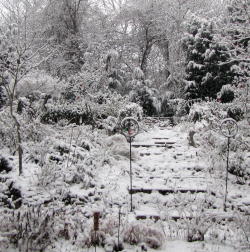
Evening primroses, such a romantic name, suggesting Victorian novels and fragrant pathways. Common evening primrose, Oenothera biennis is no shrinking violet, oh no. It is not even a primrose at all. At a strapping six feet tall, this plant has a strong presence wherever it decides to show up.

First noticed blooming at offspring Semi’s semi-wild garden, standing head and shoulders above all of the other weeds wildflowers in August several years ago, seeds were snatched, pocketed and taken home for some research before sowing. It was then we found the name of the tall vertical accent with the pale yellow blooms, Oenothera biennis and learned it was a native found in dry, well drained open places in the Eastern US and Southern Canada, common in Tennessee. It is said to be hardy in USDA Zones 5-8.

Give this plant plenty of room for the attractive branching to be shown in the spotlight along with the height. It will seed about, with a rosette appearing the first year and the flower spike shooting for the stars the second, as most biennials do.

Several common names allude to the medicinal qualities of Oenothera biennis, such as King’s cure-all, fever plant and cure-all. Headaches and skin disorders, among many other ailments are said to be relieved with compounds contained in this plant. (As always, we do not recommend self medication). The roots, seeds, oil and leaves are said to be edible and nutritious. The above photo shows the Oenothera biennis peeking out from behind the curtain of blooming bronze fennel,Foeniculum vulgare.

Oenothera biennis flowers are favored by pollinators, birds and other wildlife. While out pointing and shooting with the usual abandon with the camera set on auto, we noticed this ruby throated hummingbird darting around the red salvias. We were far away, but used the zoom to its max to follow the hummer as it dined. When it sipped on the evening primrose, my heart did a somersault as the shutter was clicked. The little bird can be seen from behind, just below the Fairegarden watermark. It is a poor shot, overexposed and cropped beyond what is proper, but still…
***
Visit my dear friend Gail of Clay and Limestone to see more wildflowers that are featured monthy when the fourth Wednesday rolls around.
Frances









Frances what a delightful wildflower. I love the yellow colors and so do apparently the wildlife…what a wonderful capture of the hummer.
Hello!
Lovely evening Primrose!
Interesting information.
Mine bloomed in June-July.
I was amazed at how fast they went from tiny bud to full bloom.
Happy Wildflower Wednesday!
Lea
Lea’s Menagerie
It’s wonderful and has many characteristics of a perfect plant for my garden, too. Easy, attracts pollinators and seeds about! Oh, and they are pretty flowers! Now to see if it did make it home from across the mountain! happy WW! xoxogail
I have the shorter kind that is a perennial, too. I’ve never heard of this tall one. What a beauty! I’m glad you cropped and pointed out the hummer. What fun! I need to finish up my WW post this evening.
I had no idea these would get so tall! I passed up some of the shorter variety at a plant sale last spring and kicked myself afterward. Love these yellow blooms, and yes, the name does evoke some images of romantic Victorian novels.
I have often thought about bringing this wildling into my garden. It is such a beautiful shade of yellow. I didn’t know it was a biennial as I see it in the same areas in the wild every year.
Had Sundrops in Virginia and it was such a bright sunny spot in the garden. I like many of the Oenotheras, but know they can spread pretty well. Have to find the best spot before planting any.
Good Morning Frances and greetings again from Canada. One of the serious joys of the oil of Evening Primrose is relieving many of the symptoms of menopause. This is a safe product and it really does work. A good and reputable Health Food Store will have it. They grew wild where I was living and I used to thank them as I drove by from all the grateful women out there. Nature always has a way to help us doesn’t it?
Very pretty! We have a similar variety here, Oenothera hookeri. I put out one plant a few years ago, and now it’s fun to see where else its offspring to decide to pop up each year. It’s always a pleasant surprise to see them.
I am afraid I have this plant in a container this year and it has performed poorly in the heat. I am ready to take that container apart for fall so I will try it in the garden. It can be a bit messy in our area so I may be sorry.
Eileen
She’s a beauty ! So how’s blotanical …did Stuart give up on giving awards ? Haven’t been there or here come to think of it in ages.
I can see a stand of these wonderful flowers from my office window as I read your post. We grow them to attract moths into the garden. Recently we have grown an orange flowered variant and they look really good too.
Beautiful photographs, beautiful flowers, I like to admire so beautiful views. I am greeting
I do love wildflowers – yet sometimes they seem so unappreciated! Yours look beautiful, you take such wonderful photos.
Simon @Ambius
This used to be a common roadside flower here in Nashville, but no more since the highway department started poisoning every verge or cutting everything to stubble-
What an absolutely beautiful blog you have, the photograghy is so lovely, now i want to grow lilies.
Pingback: Rejoice in the Changes | Fairegarden